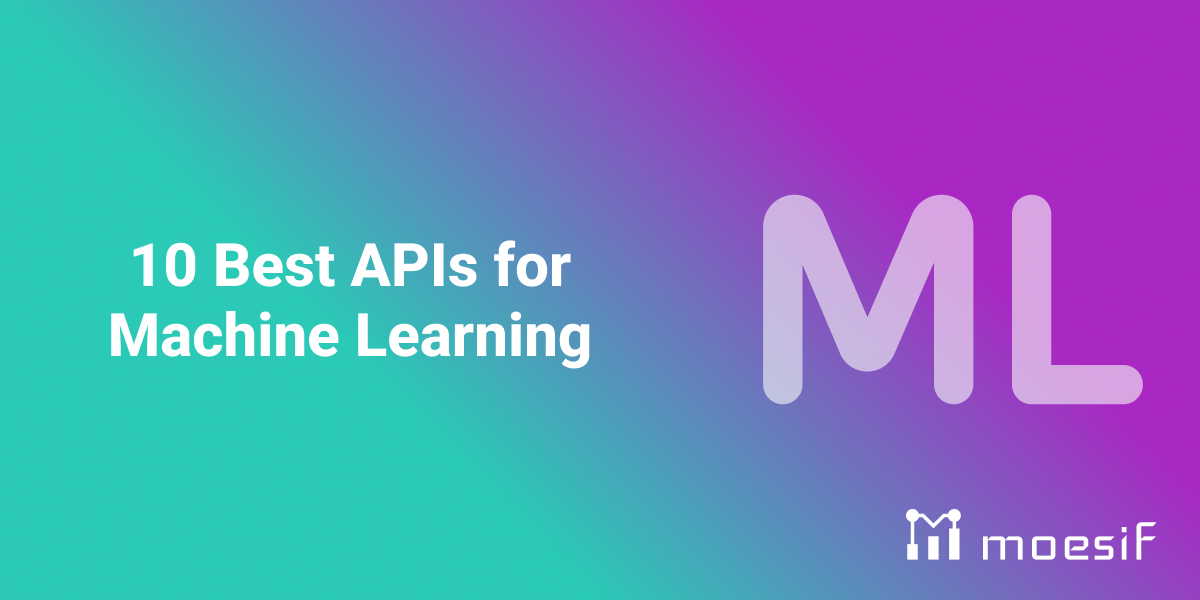10 Best APIs for Machine Learning

Machine learning APIs provide developers with powerful tools to integrate complex algorithms and models into applications without building them from scratch. These APIs simplify the development process by offering pre-trained models and standardized methods for different tasks. These include image recognition, natural language processing, and predictive analytics. This accessibility democratizes machine learning so that developers of varying expertise can leverage cutting-edge technology efficiently. When you use an API for machine learning to host models in modern web infrastructure, it greatly improves the adoption and integration of AI/ML features.
In this article, we’ve curated a list of the best APIs for machine learning. We also touch on how ML APIs benefit us, their real-world use cases, and how to achieve scalability while tackling current challenges in the landscape.
Table of Contents
- Key Takeaways
- Understanding Machine Learning APIs
- Key Benefits of Using Machine Learning APIs
- Top Machine Learning APIs for Developers
- Specialized Machine Learning APIs
- Integrating Machine Learning APIs into Your Applications
- Managing and Scaling Your Machine Learning Models
- Real-World Use Cases of Machine Learning APIs
- Common Challenges and Solutions
- Summary
Key Takeaways
- Machine learning APIs allow seamless integration of AI-powered features into applications. With little to no expertise in the field, you can get access to powerful AI models.
- Machine learning APIs accelerate product development, enhance scalability, and promotes modularity. It becomes easier to deploy AI-driven solutions across various applications.
- Leading machine learning APIs, such as OpenAI, Google Cloud AI/ML, IBM Watson Discovery, Microsoft Azure AI Services, and NLP Cloud, offer specialized tools and services. They can carry out tasks like natural language processing, image analysis, and data extraction.

Understanding Machine Learning APIs
Machine learning APIs provide standardized interfaces to powerful pre-trained models and algorithms. The standardization eases the integration process and efforts by a large margin, no matter what type of model you require or application you have. Applications can also easily establish uniform communication with different parts of software systems.
These APIs typically operate over the internet, where developers send requests to an API endpoint with data that needs processing. The API then processes this data using its machine learning models and returns a response with the desired results. This process abstracts the complexity of machine learning, allowing developers to leverage AI without delving into the details of model training or data pre-processing.
For example, in image recognition tasks, a developer can send an image file to an API endpoint designed for image analysis. The API uses its pre-trained models to identify objects or features within the image and returns the results in a structured format, such as JSON or XML. Similarly, in sentiment analysis, a developer can send a text snippet to an API that analyzes and returns the sentiment score, indicating whether the text carries positive, negative, or neutral sentiments. These APIs handle the heavy lifting of data processing and model inference so that developers can focus on the application side, integrating the results.
Apart from providing pre-trained models, many of these ML APIs offer customization options. These options allow developers to fine-tune models based on specific use cases or datasets. This customization involves providing additional data to the API, which adapts the model’s parameters to better suit the application’s needs.
Key Benefits of Using Machine Learning APIs
- You get easy access to powerful ML functionalities without having to build, train, or deploy models on your own. You don’t have to spend resources on data collection, model training, and optimization. The standardized interfaces allow for easy integration. Moreover, recycling and reuse of models significantly cuts down the time and effort to build AI-driven solutions.
- These APIs often run on cloud-based platforms. This ensures scalability according to demand and that applications can handle varying workloads without performance degradation.
- Machine learning APIs offer access to state-of-the-art models and techniques that their providers continuously update and maintain. Applications benefit from the latest advancements in AI without requiring in-depth knowledge or manual updates.
- As discussed in the preceding section, many ML APIs allow for customization. Developers to fine-tune models to suit specific needs or datasets.
ML APIs provide uniform endpoints that can interact with machine learning models. This simplifies the integration of AI functionalities into pre-existing systems.
Furthermore, you can easily establish interaction between independent components and the models without any deep integration. Such modularity enables diverse applications and users to efficiently access and utilize the AI models.
Top Machine Learning APIs for Developers
Leading providers of machine learning APIs include:
- OpenAI
- Google Cloud AI/ML
- IBM Watson Discovery
- Microsoft Azure AI Services
- NLP Cloud
Each platform offers unique capabilities, In the following sections, we discuss these platforms in more depth to help you decide the perfect one for your own applications.
OpenAI API
OpenAI provides some of the most cutting-edge artificial intelligence models available today. ChatGPT and DALL-E stand out for their versatility and performance as two of the most popular generative AI tools at present.
ChatGPT is a conversational AI model capable of generating human-like text. It’s widely used in applications such as customer support, content creation, and virtual assistants. This model’s expertise in natural language processing (NLP) tasks has made it an attractive option to developers building NLP solutions. The OpenAI API allows complete and customized access to ChatGPT’s power that developers have used to build breakthrough solutions.
DALL-E, on the other hand, excels in image generation. It can create high-quality images from textual descriptions. This has opened up new possibilities in digital art, advertising, and visual content creation.
Google Cloud AI/ML APIs
Google Cloud offers an extensive suite of AI and machine learning products designed to cater to a wide range of needs.
For example, the Vertex AI Platform offers an all-inclusive toolset for the creation, training, testing, monitoring, tuning, and deployment of AI models, including an API. Platforms like this supports developers throughout the entire machine learning lifecycle. It also includes Vertex AI Notebooks for rapid prototyping and secure experimentation.
Additionally, Google Cloud’s AI/ML suite comprises specialized APIs like the following:
- The Video Intelligence API can analyze videos to identify more than 20,000 objects, places, and actions.
- Using the Dialogflow API, developers can build natural conversational experiences into their applications.
- Speech-to-Text API provides high-accuracy speech recognition.
- Text-to-Speech API offers natural-sounding speech synthesis.
Some other AI services that Google Cloud Platform offers include the following:
- Vision AI provides pre-trained models for image recognition and analysis.
- Natural Language AI offers pre-trained models for sentiment analysis, entity recognition, and language translation.
- Translation AI provides pre-trained models for language translation/
- Document AI offers pre-trained models for data extraction and document processing.
Google Cloud gives you a unified platform where everything works out-of-the-box. Regardless of your use case, you can likely find a solution that fits. You also benefit from a pay-as-you-go pricing model that requires no upfront investment.
IBM Watson Discovery API
IBM Watson Discovery API has sophisticated data extraction and pattern analysis capabilities, making it a valuable tool for data scientists. It can also efficiently process unstructured data. Businesses use it to analyze large volumes of text and uncover hidden patterns and insights.
IBM Watson Discovery uses custom NLP models and LLMs to deliver powerful natural language processing. This makes the API a suitable tool for sophisticated text analysis—for example, in customer service applications that interpret and respond to customer queries. Furthermore, researchers and development sectors use this API to extract valuable information from extensive datasets.
Microsoft Azure AI Services
[Microsoft Azure AI Services] offer a dependable and scalable platform for an array of AI solutions. The Azure AI Language service, formerly Text Analytics service, for instance, offers pre-built models for sentiment analysis, key phrase extraction, and language detection.
These services have been designed to handle large-scale text and computer vision workflows with scalability and flexibility through cloud deployments.
NLP Cloud
NLP Cloud specializes in natural language processing tasks. The platform offers powerful tools for sentiment analysis, content moderation, and text summarization. This natural language API can classify parts of speech and analyze text to deduce language-specific metadata, making it a versatile tool for handling unstructured text.
Developers can employ NLP Cloud for generating summaries of text and web pages. This simplifies content management and improves user experiences.
Specialized Machine Learning APIs
While general-purpose machine learning APIs offer broad functionalities, specialized APIs tailor to specific tasks. They can significantly enhance the performance and accuracy of applications in niche areas.
For example:
- SkyBiometry offers advanced facial recognition and feature detection capabilities for applications that require precise facial analysis.
- Roboflow Universe’s Image Similarity API can analyze images to determine their visual similarities.
- Perspective API can detect toxic, obscene, insulting, or threatening text for use cases such as content moderation and user protection.
Let’s learn a bit more about these APIs.
SkyBiometry
SkyBiometry’s facial recognition API can detect faces in images with remarkable precision. You can detect facial features and achieve real-time face tracking. This makes it a powerful tool for security, surveillance, and user authentication applications.
Roboflow Universe
Roboflow Universe’s Image Similarity API creates a feature print between two images. A feature print represents an image’s visual features mathematically. By calculating the distance between feature points, the API can determine the similarity between two images. Developers working on projects that involve large image datasets may find this API particularly useful.
Perspective API
The Perspective API, an NLP tool, has been designed to identify and flag potentially toxic, obscene, insulting, or threatening text. It utilizes advanced algorithms to analyze language patterns and determine the level of potential harm in the text. If you want your application to moderate user-generated content and maintain a safe online environment, Perspective API can prove very useful.
Integrating Machine Learning APIs into Your Applications

The integration process begins with selecting the right API for your project requirements. For example, if you need image recognition capabilities, you may choose an API like Google Cloud Vision or Microsoft Azure’s Computer Vision API. After selection, thoroughly review the documentation to understand how to use the API, including available endpoints, authentication methods, encryption, and request-response formats. Standardized endpoints ensure consistency in how apps interact with the API.
Next, you will implement the API in your application that sends and receive data from the endpoints. This involves constructing HTTP requests with necessary parameters and authentication tokens. For example, for a text analysis API, you send a POST request to the API containing text data. Your implementation must gracefully addresses any errors that may occur. For successful responses, you must properly extract the useful information upon such as sentiment scores or classification labels.
Most importantly, you need to prepare and format the input data so that it matches the ML API’s requirements. You may need to profile, cleanse, validate, and transform your data to guarantee the data’s suitability for analysis and best results.
Pay attention to standardization of endpoints for model interactions. Platforms like UbiOps provide an easy-to-use deployment layer for data science code, maintaining endpoints in a standardized format, even when you upload new code. This standardization simplifies the integration process and ensures that applications can consistently interact with machine learning models.
Managing and Scaling Your Machine Learning Models
Managing machine learning models effectively ensures performance and reliability of your AI apps against real world problems. Here are some key points to consider:
- Tools like MLflow and TensorBoard help track key metrics such as accuracy, precision, recall, and latency, offering insights into model behavior in production environments.
- Teams can implement version control with platforms like DVC or Git to manage model changes and updates. This allows for easy rollbacks if issues arise.
- Logging and alerting systems, such as from Datadog or Prometheus, help detect anomalies or performance degradation.
- It’s also important that models remain relevant and effective as data patterns evolve. Therefore, retrain models with fresh data using automated pipelines in tools like Kubeflow.
For scaling ML models, here are some strategies to consider:
- Make sure models perform well under varying demands and increased workloads.
- Engineers can use cloud-based solutions like Kubernetes or Amazon SageMaker to orchestrate and manage resources efficiently.
- Load balancing becomes necessary to prevent any single model instance from becoming a bottleneck. To that end, tools like NGINX can distribute incoming requests across multiple instances.
- Developers can optimize models for speed and resource efficiency using techniques like quantization or model pruning. These are often implemented with frameworks such as TensorFlow Lite or ONNX.
- For custom models, storing model artifacts in a Cloud Storage bucket within the same Google Cloud project ensures accessibility and security.
Real-World Use Cases of Machine Learning APIs
Machine learning APIs have played a crucial role in resolving real-world issues across diverse industries. For example:
- In healthcare, organizations like Highmark Health use AI to improve efficiency in care delivery, drug discovery, and clinical trial planning. The U.S. Dept. of Veterans Affairs leverages AI for enhanced accuracy in cancer detection at remote military facilities.
- Snapchat’s My AI chatbot uses OpenAI’s GPT series of large language models (LLM).
- Khan Academy’s Khanmigo offers personal tutoring and teaching assistance that uses OpenAI’s GPT-4.
- In the transportation sector, the Central Texas Regional Mobility Authority utilizes Vertex AI to modernize operations, improving efficiency and service delivery.
- In customer service, companies like Best Buy and Magalu have created AI-powered virtual assistants to enhance customer engagement and support.
- Additionally, Woven, a Toyota investment, employs AI for autonomous driving.
Common Challenges and Solutions
The implementation of machine learning solutions presents its own unique set of challenges.
- ML models rely on large, diverse, and high-quality datasets. Otherwise, models perform poorly and yield inaccurate results. Thorough data cleaning, preprocessing, and augmentation techniques can ensure data quality and address imbalances. Investing in data collection and labeling efforts also help improve data availability.
- Feature selection, a process that involves pinpointing the most pertinent features from an extensive dataset, can be quite a time-intensive process. Effective feature selection is necessary for building accurate models, and various techniques and tools can aid in this process.
- Optimizing ML models require tuning hyperparameters to adjust learning rates and performance. Proper data preprocessing and optimization techniques can ensure that models receive proper training and perform well in real-world applications.
Summary
Throughout this blog post, we have discussed how machine learning APIs work and the different types that exist for different use cases. The AI space has been evolving fast. The future seems promising to see AI democratization get more mainstream appeal in tandem with these new innovations. Trends such as open-source AI and machine learning APIs corroborate the global community’s commitment to making AI simpler and more accessible to users.
Now it’s possible more than ever to build impactful products utilizing the robust ecosystem of machine learning and AI APIs. But for the critical challenges that lie ahead, it’s important to continuously monitor, understand, and research different aspects of an AI product.
For AI products or APIs, Moesif makes some of these challenges very easy to tackle by providing in-depth analytics of your product’s journey.
Moesif gives you a comprehensive suite of powerful analytics and monitoring tools. You also get access to robust monetization features so that you can grow your AI product with confidence. You can integrate Moesif easily with your favorite APIM platform or API gateway through one of our easy-to-use plugins. You can also directly embed Moesif into your API code using our SDKs. With Moesif at your disposal, your API’s lifecycle becomes robust, accelerating product growth.
To try it yourself, sign up today for a free trial, no credit card required.





